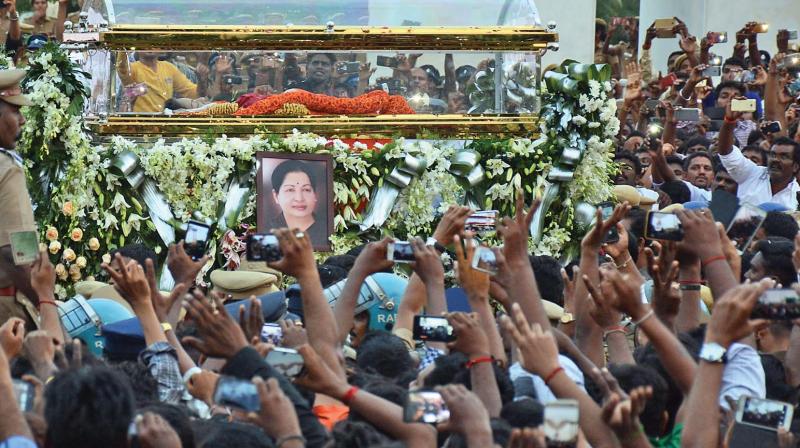AIADMK unity efforts: Narrative needs more than thermocol shields

Chennai: This is much slower than a Tsunami wave. For it has come at a time when Tamil Nadu is going through its worst drought in the last 140 years, farmers having nowhere to go and people lining up for water on a daily basis, a spectacle recently seen post-demonetisation.
This is the power struggle in the All India Anna Dravida Munnetra Kazhagam, five months after the demise of its charismatic leader J Jayalalithaa in December 2016. The ruling party in Tamil Nadu, despite its majority in the Assembly, is today better known by its two factions- AIADMK (Amma) and AIADMK (Puratchi Thalaivi Amma).
This nuanced differential baptism, albeit interim, adding to the lexicon of Dravidian party splits, we owe to the Election Commission, which had no time to resolve the party’s ‘Two Leaves’ symbol dispute before the recently cancelled bypoll to the R.K. Nagar constituency. Its electorate had elected ‘Amma’ twice, thus making it a contested turf for claims to her political legacy too.
The internal quest for control of the party, between those owing allegiance to the late Chief Minister’s confidante, Ms Sasikala Natarajan, who sees prison walls as no limitation after the final verdict in the assets case, her kin whose visibility has been enhanced by the former AIADMK MP, TTV Dhinakaran, and the supporters of the pious-looking former Chief Minister, Mr. O. Panneerselvam - camouflages a deeper disconnect in the state polity.
This is an unenviable situation for a State known to be socially and politically progressive, and yet today finds itself in a huge narrative stalemate. Which faction is the “more revolutionary” evolution of the extended MGR-Jayalailithaa legacy, is not something the EC can decide. The RK Nagar bypoll, if it had gone through, could have shown the way, but now the eventual political resolution might have to await a possible general election, a likely scenario the BJP would only be very pleased about.
But one is not really into futuristic or political astrology here. That can at best be only a temporal dimension to the crisis and the latest efforts by both the AIADMK factions to form respective committees to begin talks for merging both the groups, brings alive a memory, tangentially at best. The late Odisha gentleman-politician Biju Patnaik, in the interests of the Dravidian Movement, tried a merger of both DMK and AIADMK when the latter’s popular founder-leader MG Ramachandran was the reigning star.
A formula was even arrived at to let the DMK president Mr M Karunanidhi retain control of the parent party organisation, while MGR would continue as Chief Minister, but that initiative quickly came to naught.
That outcome makes any jump to the present historically unrealistic, given the present Chief Minister, Mr. Edappadi K Palanisamy, only the second from the influential OBC Goundars-dominated western belt since the heyday of Rajaji, is in a very asymmetrical slot, ‘Amma’ being the only commonality.
Notwithstanding the three principal conditions set by OPS for any forward movement of the merger talks now - that includes political hibernation for the Sasikala family and consent for a Central probe into the unravelled aspects of Ms Jayalalithaa’s death - both the OPS and TTV factions of the AIADMK are missing out on the larger narrative that, wittingly or unwittingly, have come to define their political existence and party identity.
In effect, it is a bitter and deep moment of truth for what constitutes the political process for the regional parties in India’s multi-dimensional polity today. And it is here that both factions of the AIADMK need to think deeper, as much as the other key players, in a State where a modicum of charismatic leadership has come to impart political stability.
This does not imply creating new personality cults, far from it. But it is an hour to bring home the positive aspects of leadership legacies that should make the unity efforts meaningful, and acknowledge its semantics in the proper historical perspective.
For all her autocratic style of functioning and charges of corruption against her successive regimes, amid attempts to now debunk her era totally, Jayalalithaa had been successful in taking forward the social compact that the DMK and AIADMK had enabled for Tamil Nadu’s advancement in the post-1967 decades after Congress lost power.
This process does weigh heavily on any polity. Just as there is a brighter side to the DMK’s contributions to development of Tamil Nadu, there is equally a positive side to the MGR-Jayalalithaa legacy. Personally, for example, she gave away her jewellery to the ‘National Defence Fund’ when Lal Bahadur Shastri was the Prime Minister during the 1965 Indo-Pak War and had done several classical dance shows to raise funds for good causes including for a sports stadium in Tiruchirappalli. These and others testify to how she gave a considerable part of her life to the State’s politics and development.
When Ms Jayalalithaa finally departed, draped in her own enigma, mystery of sorrow and personal pain, it was also a grim reminder that not all moral dilemmas are perfectly resolvable.
It is finally that legacy of “service to the people” that would lend greater depth and significance to any unity efforts now, something more substantial than the Thermocol shields the Madurai administration is trying with to stem evaporation losses from the poor water storage in the Vaigai dam.

